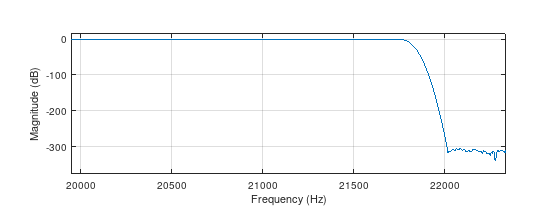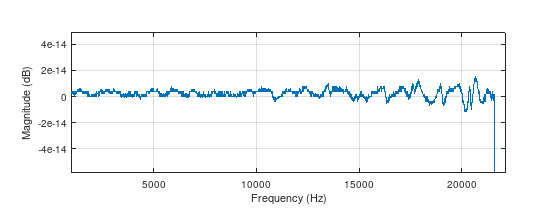All practical sinc filters are windowed, since the theoretical sinc filter is infinite.
You’re repeating what I already hinted earlier regarding closer to ideal (not ideal).
HQPlayer offers 2 million+ tap sinc filter btw…
It’s not my personal favourite sounding filter though.
Since I can generate my own, I can always add one to the number of taps in the longest HQPlayer filter. I don’t need that though, since after a certain threshold, those numbers don’t mean anything anymore, just marketing.
sure, once you know the stuff this is possible. but Jussi is doing really great work there imo. to me this is all just a hobby. not a professional in audio. so i appreciate Jussi´s great work a lot and each time he comes up with something new it is like a little xmas 
well, we should not forget about the hardware too. but it is a matter of money too imo!
Chord Hugo M Scaler - Stereophile Review (measurements also) | Audio Science Review (ASR) Forum (they reference hqplayer too)
Just to summarise, you’ve gone from saying (guessing?) that Roon’s linear phase + fast roll-off filter is a sinc filter (wrong?) to saying your own Chebyshev windowed sinc filter is better…
![]()
Can we agree first that all sinc filters are actually windowed sinc filters?
hihi, I believe your discussion is getting too theoretical for me. as a consumer i like to enjoy music and having fun. letting pros come up with cool solutions enabling this, be it software or hardware. i mean they work for this to enable this. sure, myself having fun to play around with DSPs etc (see above link to Hifiberry DSP), but this is all fun. Pros focussed on this topic come up with solutions that are much better than my fun stuff. But all up to personal preferences and what you like to spend your time for 
to come back to your original question . yes, myself likes roon in combination with hqp a lot. more than roon alone. i like hqp because of its modulators and filters. not so much because of the other stuff. others is easy to achieve with other tools imo. so, like written here at first reply: just try it and decide if you like it or not.
so myself out here now. as too theoretical for me without value. sorry and have fun.
Performance-wise Roon has it’s own limitations, for example, limits 1 core per zone.
Note that Roon currently runs the DSP engine on one CPU core per zone–so this reflects the load relative to consuming a full core. “2.0x” means you’re using 50% of one CPU core to play music in this zone.
In the Roon DSP pipeline, please try 6-channel room correction for MCH DSD256 playback. It should be fun. ![]()
HQPlayer can locate multiple CPU cores (and supported GPU, if you have it) to do the DSP. No more single core restrictions.
Roon does not have 6MHz family DSD upsampling, and also does not have 1024fs+ upsampling option so far. Based on these reasons I go with HQPlayer.
It seems my guessing was right. This is the normalized response of Roon’s linear phase up-sampling filters, side-by-side:
The precise is enough of a brick-wall, although still a bit leaky, having only about -60dB attenuation at Nyquist rate. There is definitely room for improvement here. The smooth is way leakier and starts rolling off before 20kHz, as you would expect from a slow roll-off filter.
Nice try ![]() You’ve tried to wiggle from your earlier statements but it’s obvious.
You’ve tried to wiggle from your earlier statements but it’s obvious.
No different to the screenshot I shared earlier…
There are filters in HQPlayer closer to the ideal sinc filter, if sinc is what floats your boat.
So in this particular regard, HQPlayer DSP is better than Roon (your thread title)
![]()
![]()
![]()
Yeh HQPlayer
I’m not sure you’ve read the Archimago’s recent post about the new sinc- filters of HQPlayer but I’m quite certain your “brickwall” definition was different to me. ![]()
What kind of sinc filter?
One with a very small passband ripple throughout the audible band and a very high stopband attenuation from Nyquist frequency up. Whether it’s an actual windowed sinc or derived through other means (like Parks-McClellan), it doesn’t really matter.
You should also consider the possible errors from the ADC filters.
Apart from that, something like this would be your preference?

Ripple plots get difficult too because the presentation tooling is becoming limiting

Thank you for sharing  (btw myself pretty happy with the current preset way as faster and easier switching possible imo)
(btw myself pretty happy with the current preset way as faster and easier switching possible imo)
All you guys must have amps, speakers and listening rooms, or just headphones, made from unobtainium - not to speak about your ears and brains - since it seems you can resolve and appreciate differences below about minus 120dB or even just passband ripple on the order of a fraction of a fraction of a dB.
Yes, that’s an extremely good filter. But if it takes 5M taps to do that, what’s the point? With all due respect, those numbers are simply ridiculous. As I said before, after a certain threshold, they don’t mean anything beside pure marketing.
My filter (200 sinc side lobes, Chebyshev window, 1000 samples per lobe, so a max of 400K taps) looks like this:
Attenuation is under -1E-6 at 20kHz, -144dB at Nyquist and the ripple is absolutely negligible, so it’s still ridiculous for humans.
Thats just so… 80’s… 
When you use DSP directly with DSD, you’re processing at least 6 octaves of nothing but quantization noise - 8 octaves for DSD256. That is a complete waste of computing.
You mean 48k-based DSD? What is that for again? Last time I checked, you could convert from 48kHz to 5.6MHz.
Um, yeah, that’s a limitation… I guess you’ll soon move to 2048fs. Will this nonsensical arms race ever end?


